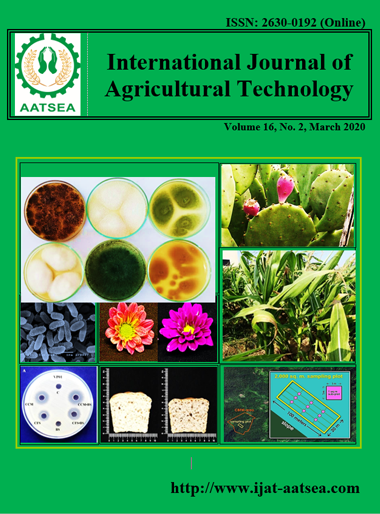Floods increase soil microbial activity in paddy soil: a case study in Sakon Nakhon province, Thailand
Main Article Content
Abstract
The results showed that the different flooding histories caused the effects on some soil properties. Partially flooded areas had the highest soil electrical conductivity at 0.06 mS/cm, but in the range that did not affect plant growth. All studied areas had low levels of organic matter and fields had available phosphorus of less than 4 mg/kg. There was a low level of exchangable potassium under fully flooded areas but a high level under partially flooded and non-flooded areas. The microbial activity revealed the highest soil respiration under fully flooded areas with 0.16 mgCO2/g soil. The highest bacterial and fungal populations, FDA activity, urease, dehydrogenase, and protease activities were found under fully flooded area conditions. However, soil pH, microbial biomass carbon, microbial biomass nitrogen, and acid-phosphatase activity were not statistically different. No pesticides in carbamate, organochloride, and organophosphate groups were observed. The amounts of mercury, arsenic, lead, and cadmium were lower than the standard set of Thailand. Flooding did not reduce soil quality in the areas of the study; on the other hand, increased microbial activities were beneficial for plant growth. The effects of flooding on soil properties might differ depending on the conditions in each area.
Article Details

This work is licensed under a Creative Commons Attribution-NonCommercial-NoDerivatives 4.0 International License.
References
APHA (2005). Standard Methods for the Examination of Water and Wastewater. 21st Edition, American Public Health Association/American Water Works Association/Water Environment Federation, Washington DC.
British Standard (2008). Foods of plant origin-Determination of pesticide residues using GC-MS and/or LC-MS/MS following acetonitrile extraction/partitioning and clean-up by dispersive SPE-QuEChERS-method. European Committee for Standardization, Brussels. pp.84.
Brookes, P. C., Landman, A., Puden, G. and Jenkinson, D. S. (1985). Chloroform fumigation and the release of soil nitrogen: a rapid direct extraction method to measure microbial biomass nitrogen in soil. Soil Biology and Biochemistry, 17:837-842.
Casida, L., Klein, D. and Santoro, T. (1964). Soil dehydrogenase activity. Soil Science, 98:371-376.
Eivazi, F. and Tabatabai, M. A. (1977). Phosphatases in soils. Soil Biology and Biochemistry, 9:167-172.
Kandeler, E. and Gerber, H. (1988). Short-term assay of soil urease activity using colorimetric determination of ammonium. Biology and Fertility of Soils, 6:68-72.
Ladd, J. N. and Butler, J. H. A. (1972). Short-term assays of soil proteolytic enzyme activities using proteins and dipeptide derivatives as substrates. Soil Biology and Biochemistry, 4:19-30.
Lehmann, J. and Schroth, G. (2003). Nutrient leaching. In: Schroth, G. and Sinclair, F. L. eds. Trees, crops and soil fertility, Wallingford, CAB International Publishing, pp.151-166.
Mendes, W. C., Alves, J. Jr., Cunha, P. C. R., da Silva, A. R., Evangelista, A. W. P. and Casaroli, D. (2016). Potassium leaching in different soils as a function of irrigation depths. Revista Brasileira de Engenharia Agrícola e Ambiental, 20:972-977.
National Environmental Board (2004). Soil quality standard (in Thai). Government gazette number 121 special issue 119 d, pp.170-181.
Rice, C. W., Moorman, T. B. and Beare, M. (1996). Role of microbial biomass carbon and nitrogen in soil quality. In: Doran J. W. and Jones A. J. eds. Methods for assessing soil quality. Madison, Soil Science Society of American Incorporation, pp.203-215.
Rosolem, C. A., Sgariboldi, T., Garcia, R. A. and Calonego, J. C. (2010). Potassium leaching as affected by soil texture and residual fertilization in tropical soils. Communication in Soil Science and Plant Analysis, 41:1934-1943.
Schnürer, J. and Rosswall, T. (1982). Fluorescein diacetate hydrolysis as a measure of total microbial activity in soil and litter. Applied and Environmental Microbiology, 43:1256-1261.
Singkran, N. (2017). Flood risk management in Thailand: shifting from a passive to a progressive paradigm. International Journal of Disaster Risk Reduction, 25:92-100.
Tabatabai, M. A. and Bremner, J. M. (1969). Use of p-nltrophenyl phosphate for assay of soil phosphatase activity. Soil Biology and Biochemistry, 1:301-307.
Vance, E. D., Brookes, P. C. and Jenkinson, D. S. (1987). An extraction method for measuring soil microbial biomass C. Soil Biology and Biochemistry, 19:703-707.
Walkley, A. and Black, I. A. (1946). An examination of Degtjareff method for determining soil organic matter and a proposed modification of the chromic acid titration method. Soil Science, 37:29-37.
Wu, F., Sun, Y., Sun, Z., Wu, S. and Zhang, Q. (2019). Assessing agricultural system vulnerability to foods: a hybrid approach using emergy and a landscape fragmentation index. Ecological Indicators, 105:337-346.
Yang, W., Yang, Y., Ding, Z., Yang, X., Zhao, F. and Zhu, Z. (2019). Uptake and accumulation of cadmium in flooded versus non-flooded Salix genotypes: implications for phytoremediation. Ecological Engineering, 136:79-88.


